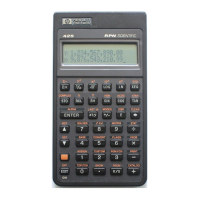Now we do RCL A RCL B MATRIX ▼ CROSS which gives the answer, which we can see using
the EDIT function.
The HP-42S Owner's Manual fails to mention the existence of three additional useful matrix
functions:
[MIN] - Gets a column's smallest element.
[MAX] - Get a column's largest element.
[FIND] - Searches a matrix for a given element.
These additional functions were discovered independently by Joseph K. Horn,; his documentation can
be found at
http://www.hp42s.com/docs/hidden_matrix_functions.html.
11 Other Bases
To work with other bases we must use the BASE menu (over the “4”). This menu has the
following functions:
A...F: Select hexadecimal mode and show A to F.
HEXM: Select hexadecimal mode.
DECM: Decimal mode.
OCTM: Octal mode.
BINM: Binary mode.
LOGIC: Show the logic functions AND, OR, XOR, NOT, BIT?, ROTXY.
Example: How do we write 500 in hexadecimal mode?
Solution: In decimal mode enter 500 and then select HEXM. You will find 1F4.
12 Flags
The HP-42S has 100 flags from 00 to 99. A flag is a “binary memory” which works as an indicator
of calculator's status. A flag can be “set” (true) or “clear” (false). Just for comparison the 33S has only
12 flags.
But why do we need flags? Why not set up the calculator status using just the default menus? For
me the most interesting reason is related to programming. Using flags you can get the status of the
calculator or change it from a program.
To work with flags there are some functions in the FLAGS menu (over the “6”) which are SF, CF,
FS?, FC?, FS?C, FC?C (again the HP-42S has more functions than we need).
SF: Set flag. Makes a flag to be set (true).
CF: Clear flag. Makes a flag to be clear (false).
FS?: Flag set test. True if the flag is set (true).

